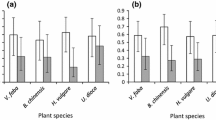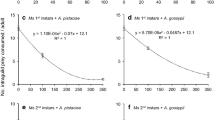Abstract
Life tables for two predatory ladybirds,Coccinella septempunctata andHarmonia axyridis, were constructed in two years in which prey abundance differed. The prey aphid,Aphis gossypii, was abundant on its primary host from late May to late June. Females ofH. axyridis andC. septempumctata laid their eggs during the increase and peak in aphid abundance. The oviposition period ofC. septempunctata started before and was shorter than that ofH. axyridis. In both species, intraguild predation and/or cannibalism of the egg and fourth instar stages, but rarely of other developmental stages, were observed. Fourth instar larvae ofH. axyridis had to complete their development when aphids were scarce more frequently than those ofC. septempunctata. The highest frequency of intra- and interspecific predation was of fourth instarH. axyridis larvae. In terms of intraguild predation, the larvae ofH. axyridis preyed on larvae ofC. septempunctata, but the reverse was not observed. Percentage survival from egg to adult inH. axyridis was higher than inC. septempunctata in both years, and least in both species in the year of low aphid abundance. These results suggest that prey abundance influenced the frequency of cannibalism and intraguild predation, which were important in structuring this guild of ladybirds.
Résumé
Des tables de survive pour deux coccinelles prédatrices,Coccinella septempunctata etHarmonia axyridis, ont été établies au cours de deux années où l’abondance en proies était différente. La proie,Aphis gossypii, était abondante sur l’hôte primaire de la fin mai à la fin juin. Les femelles d’H. axyridis et deC. septempunctata ont pondu leurs œufs pendant la période de multiplication et le pic d’abondance des pucerons. Par rapport àH. axyridis, la période d’oviposition deC. septempunctata a débuté plus tôt et a été plus courte. Chez les deux espèces, on a observé la prédation intra-guilde et/ou le cannibalisme du stade œuf et du 4e stade larvaire, mais rarement celui des autres stades de développement. Les larves du 4e stade d’H. axyridis ont dû, plus souvent que celles deC. septempunctata, achever leur développement alors que les pucerons devenaient rares. La fréquence de prédation inter- et intraspécifique la plus élevée a été observée chez les larves du 4e stade d’H. axyridis. En termes de prédation intraguilde, les larves deH. axyridis peuvent se nourrir des larves deC. septempunctata, mais l’inverse n’a pas été observé. Le taux de survie de l’œuf à l’adulte a été plus élevé chezH. axyridis que chezC. septempunctata durant les deux années, et plus faible chez les deux espèces l’année où les pucerons étaient moins abondants. Ces résultats suggèrent que l’abondance des proies influe sur la fréquence du cannibalisme et de la prédation intraguilde, ce qui est important dans la structuration de cette guilde de coccinelles.
Similar content being viewed by others
References
Aalbersberg, Y. K., Van der Westhuizen, M. C. &Hewitt, P. H. — 1988. Natural enemies and their impact onDiuraphis noxia (Mordvilko) (Hemiptera: Aphididae) populations. —Bull. Entomol. Res., 78, 111–120.
Agarwala, B. K. &Dixon, A. F. G. — 1991. Cannibalism and interspecific predation in ladybird. In: Behaviour and impact of Aphidophaga. (L. Polgar, R. J. Chambers &I. Hodek (eds.)). —SPB Academic Publishing, The Hague, The Netherlands, 95–102.
Agarwala, B. K. &Dixon, A. F. G. — 1992. Laboratory study of cannibalism and interspecific predation in ladybirds. —Ecol. Entomol., 17, 303–309.
Arakaki, N. — 1992. Seasonal occurrence of the sugar cane woolly aphid,Ceratovacuna lanigera (Homoptera: Aphididae), and its predators in sugar cane fields of Okinawa Island. —Appl. Entomol. Zool., 27, 99–105.
Banks, C. J. — 1957. The behaviour of individual coccinellid larvae on plants. —Br. J. Anim. Behav., 5, 12–24.
Dixon, A. F. G. — 1996. Sex, size and foraging strategies of ladybird beetles. —Jpn. J. Appl. Entomol. Zool., 40, 185–190.
Dong, Q. &Polis, G. A. — 1992. The dynamics of cannibalistic populations: a foraging perspective. In: Cannibalism; ecology and evolution among diverse taxa (M. A. Elgar &B. J. Crespi (eds.)). —Oxford Science Publications, New York, 13–37.
Elliott, N., Kieckhefer, R. &Kauffman, W. — 1996. Effects of an invading coccinellid on native coccinellids in an agricultural landscape. —Oecologia, 105, 537–544.
Evans, E. W. — 1991. Intra versus interspecific interactions of ladybeetles (Coleoptera: Coccinellidae) attacking aphids. —Oecologia, 87, 401–408.
Hemptinne, J.-L., Dixon, A. F. G. &Coffin, J. — 1992. Attack strategy of ladybird beetles (Coccinellidae): factors shaping their numerical response. —Oecologia, 90, 238–245.
Hodek, I. &Honek, A. — 1988. Sampling, rearing and handling of aphid predators. In: Aphids, their biology, natural enemies and control (A. K. Minks &P. Harrewijn (eds.)). — Vol. 2B,Elsevier, Amsterdam, 311–321.
Hokyo, N. &Kawauchi, S. — 1975. The effect of prey size and prey density on the functional response, survival, growth and development of a predatory pentomid bug,Podisus maculiventris Say. —Res. Popul. Ecol., 16, 207–218.
Hubbard, S. F., O’Malley, S. L. O. &Russo, R. — 1988. The functional response ofToxorhynchites rutilus rutilus to changes in the population density of its preyAedes aegypti. —Med. Vet. Entomol., 2, 279–283.
Kawai, A. — 1978. Sibling cannibalism in the first instar larvae ofHarmonia axyridis Pallas (Coleoptera, Coccinellidae). —Kontyu, 46, 14–19.
Kiritani, K. &Nakasuji, F. — 1967. Estimation of the stage-specific survival rate in the insect population with overlapping stages. —Res. Popul. Ecol., 9, 143–152.
Matsura, T. — 1976. Ecological studies of a coccinellid,Alelocaria hexaspilota Hope I. Interaction between field populations ofA. hexaspilota and its prey, the walnut leaf beetle (Gastrolina depressa Baly). —Jap. J. Ecol., 26, 147–156.
Matsura, T. &K. Morooka. — 1983. Influences of prey density on fecundity in a mantis,Paratenodera angustipennis (S.). —Oecologia, 50, 291–295.
Mills, N. J. — 1989. Voracity, cannibalism and coccinellid predation. —Ann. Appl. Biol., 101, 144–148.
Osawa, N. — 1989. Sibling and non-sibling cannibalism by larvae of a lady beetleHarmonia axyridis Pallas (Coleoptera: Coccinellidae) in the field. —Res. Popul. Ecol., 31, 153–160.
Osawa, N. — 1992. Sibling cannibalism in the ladybird beetleHarmonia axyridis: Fitness consequences for mother and offspring. —Res. Popul. Ecol., 34, 45–55.
Osawa, N. — 1993. Population field studies of the aphidophagous lady beetleHarmonia axyridis Pallas (Coleoptera: Coccinellidae): life tables and key factor analysis. —Res. Popul. Ecol., 35, 335–348.
Polis, G. A., Myers, C. A. &Holt, R. — 1989. The evolution and dynamics of intraguild predation between potential competitors. —Annu. Rev. Ecol. Syst., 20, 297–330.
Power, M. E. — 1992. Top-down and bottom-up forces in food webs: do plants have primacy. —Ecology, 73, 733–746.
Rosenheim, J. A., Wilhoit, L. R. &Armer, C. A. — 1993. Influence of intraguild predation among generalist insect predators on the suppression of an herbivore population. —Oecologia, 96, 439–449.
Sakuratani, Y. — 1977. Spatial distribution pattern of the low density populations of aphids in the corn fields. —Jap. J. appl. Ent. Zool., 21, 66–73.
Solomon, M. E. — 1949. The natural control of animal populations. —J. Anim. Ecol., 18, 1–35.
Spitze, K. — 1985. Functional response of an ambush predator:Chaoborus americanus predation onDaphnia pulex. —Ecology, 66, 938–949.
Takahashi, K. — 1987. Cannibalism by the larvae ofCoccinella septempunctata bruckii Mulsant (Coleoptera: Coccinellidae). —Jpn. J. Appl. Entomol., 31, 201–205.
Takashi, K. — 1989. Intra- and inter-specific predations of lady beetles in spring alfalfa fields. —Jpn. J. Entomol., 57, 199–203.
Winder, L., Hirst, D. J., Carter, N., Wratten, S. D. &Sopp, P. I. — 1994. Estimating predation of the grain aphidSitobion avenae by polyphagous predators. —J. Appl. Ecol., 31, 1–12.
Yasuda, H. — 1995. Effect of prey density on behaviour and development of the predatory mosquito,Toxorhynchites towadensis. —Entomol. Exp. Appl., 76, 97–103.
Yasuda, H. &Hashimoto, T. — 1995. Prey density effect on cannibalism byToxorhynchites towadensis (Diptera: Culicidae). —J. Med. Entomol., 32, 650–653.
Zheng, Y., Hagen, K. S., Daane, K. M. &Mittler, T. E. — 1993a. Influence of larval dietary supply on the food consumption, food utilization efficiency, growth and development of the lacewingChrysoperla carnea. —Entomol. Exp. Appl., 67, 1–7.
Zheng, Y., Daane, K. M., Hagen, K. S. &Mittler, T. E. — 1993b. Influence of larval food consumption on the fecundity of the lacewingChrysoperla carnea. —Entomol. Exp. Appl., 67, 9–14.
Author information
Authors and Affiliations
Rights and permissions
About this article
Cite this article
Hironori, Y., Katsuhiro, S. Cannibalism and interspecific predation in two predatory ladybirds in relation to prey abundance in the field. BioControl 42, 153–163 (1997). https://doi.org/10.1007/BF02769893
Published:
Issue Date:
DOI: https://doi.org/10.1007/BF02769893




